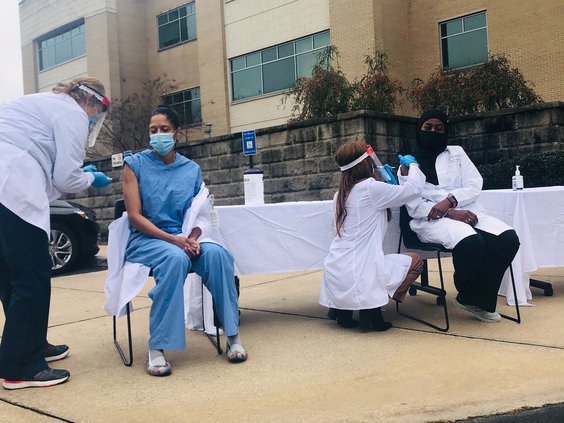Front line workers were among the first to receive the COVID-19 vaccine produced by Pfizer after it was distributed across Georgia and other parts of the U.S. earlier this week.
The first to be vaccinated in Newton County were employees of Piedmont Newton Hospital. Piedmont Healthcare held a training exercise Thursday at Piedmont Rockdale Hospital in Conyers in conjunction with Gwinnett, Newton and Rockdale Health Departments to teach its employees how to conduct vaccinations. Approximately 100 Piedmont employees in the CDC’s high-risk category, were on the receiving end of the vaccine.
As of Thursday afternoon, the cumulative total of COVID-19 cases statewide was 488,388 with 9,302 confirmed deaths and 38,418 hospitalizations, according to the Georgia Department of Public Health (GDPH). There have been approximately 59,791 new cases within the last two weeks.
In Newton County, there were a cumulative total of 4,005 cases with 110 deaths. Within the last two weeks, there have been 575 new cases across the county.
Who gets the vaccine first?
The GPDH recently unveiled a distribution plan for administering the vaccine, which involves a three-phase plan.
In Phase One, while the vaccine’s availability is limited, critical populations will take priority including health care workers who have the potential to be directly or indirectly exposed to COVID-19; and residents and staff in long-term care facilities. Then essential workers that play critical roles in keeping society up and running, police and fire personnel, other critical workforce employees (pharmacy staff, teachers and school employees, food processors, grocery store employees, transportation staff, power plant employees, air traffic controllers, etc.) and people over the age of 65 who have comorbidities and their caregivers will be vaccinated. Once those rounds of vaccinations are completed, Phase One ends with people at higher risk for severe COVID-19 illness who weren’t vaccinated in previous rounds, adults age 65 and older and caregivers and adults below age 65 with comorbidities being vaccinated.
As the vaccine’s availability increases, Phase Two of the distribution will begin. This will include nonclinical public health, hospital and long-term care facility workers and their family members; individuals in homeless shelters; individuals in congregate settings (dorms, group homes); staff and individuals in jails, prisons, detention centers; and adults aged 31-64.
The final phase will begin once the vaccine is widely available. This includes vaccinating the general population and children, once the vaccine is approved for pediatric use.
State leaders decide where and when the vaccine is distributed among Georgia’s 18 public health districts based on population density, level of disease and numbers of priority populations.
Pfizer is the only FDA-approved vaccination available as of Friday before The Covington News’ deadline, but the organization is expected to approved a Moderna-produced vaccine soon.
How does the vaccine work?
According to the CDC, COVID-19 vaccines are designed to help a person’s body develop immunity to the virus that causes COVID-19 without having to get the illness.
“Different types of vaccines work in different ways to offer protection, but with all types of vaccines, the body is left with a supply of ‘memory’ T-lymphocytes as well as B-lymphocytes that will remember how to fight that virus in the future,” the CDC states.
It typically takes a few weeks for the body to produce T-lymphocytes and B-lymphocytes after vaccination, according to the CDC, so it is possible that a person could contract the novel coronavirus just before or just after vaccination and then get sick because the vaccine did not have enough time to provide protection.
“Sometimes after vaccination, the process of building immunity can cause symptoms, such as fever,” the CDC states. “These symptoms are normal and are a sign that the body is building immunity.”
The CDC reports that all but one of the COVID-19 vaccines currently in Phase 3 clinical trials in the U.S. use two shots. The first shot starts building protection and a second shot a few weeks later is needed to get the most protection the vaccine has to offer.
One vaccine in Phase 3 clinical trials only needs one shot.
More information on COVID-19 and the vaccine can be found at CDC.gov.
What’s the cost?
The COVID-19 vaccine will be available to everyone at no cost through 2021, regardless of a person’s insurance coverage or lack thereof. After all, U.S. taxpayer dollars have paid for vaccine research and doses. However, the CDC states, “Vaccination providers will be able to charge an administration fee for giving the shot to someone. Vaccine providers can get this fee reimbursed by the patient’s public or private insurance company or, for uninsured patients, by the Health Resources and Services Administration’s Provider Relief Fund.”





